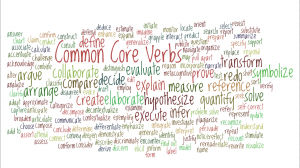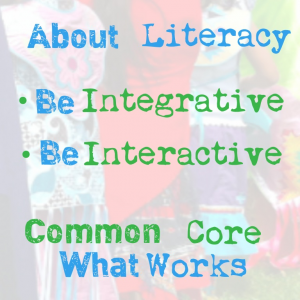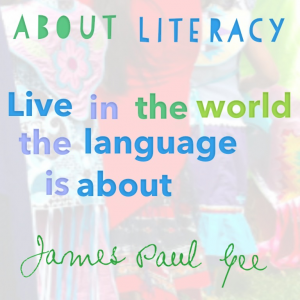Common Core: What Works?
On a field trip with my sixth grade students, we stopped at a park across the street from an ice cream parlor. As I walked back from the store to the park with the last group of kids, one of them looked down at the crosswalk markings and asked, “What are those white lines for anyway?”
Crosswalk. That’s a pretty important word for city kids for safety. It’s doubly important for a rural kid visiting the big city. But until we were there, walking in the crosswalk, the whole implication for its meaning was just a blur, a word we said without real understanding.
Vocabulary. The Common Core State Standards has plenty. Robert Marzano pulled from the CCSS a list of the common core cognitive verbs representing the thinking strategies students must do when accomplishing the standards. His ASCD article explains six steps to teach these cognitive verbs.
However, like the word crosswalk, like any word or concept, we must “Experience first; live in the world that the language is about,” says James Paul Gee in this Vialogue on Learning and Literacy He adds, “If you have lived in the world the language is about, if you have an image and actions and practices with other people to associate the words, then it’s easy.”
As language arts teachers, we understand this. Douglas Fisher and Nancy Frey remind us that:
“In particular, students need to use target vocabulary in their spoken language before they can be expected to use it in more formal written language. As Bromley (2007) reminds us, Language proficiency grows from oral competence to written competence. All students benefit from purposeful use of new vocabulary within the context of meaningful and engaging activities. This is even more critical for adolescent English language learners who are simultaneously learning English while learning in English (Fisher, Frey, & Rothenberg, 2008). “p. 4 [emphasis added]
Therefore, we and the students need to be doing these thinking activities and using the language, talking about them before we expect students to understand them and apply them in their reflections on “I can….”
With so many words and concepts to learn, and so many standards, how do we accomplish this?
Think Integrative. Think Interactive.
Integrate the standards into projects that promote interactive teamwork and discussion to create a product. During the discussions and conferences, use, define, and act on the concepts, strategies, and vocabulary relevant to that integrated goal. Live the experience of the goal.
For example, last February as Digital Literacy Day approached, many of our language arts students wondered these questions:
How do we share our information in a more interesting way, like a website does?
How can images add to and make more clear [complement] information?
On our topic, what information should be backed with media and how will we choose?
So we adapted an activity suggested by Digital Literacy Day at: Paper Cut Outs to live those ideas and decisions. See the activity in the embedded document at the end of this post (or here), which includes the integrated standards and the interactive team components [ “Team Discussions”].
At each step, students are collaborating to analyze the information and media in their research and their own decisions for media that matches their topic for their blogs. As facilitator to the groups, I pop into their discussions to guide them in vocabulary, collaboration, strategies, concepts, decision-making, etc. This is where students “live in the world that the language is about.” This is the “context of meaningful and engaging activities.”
As Fisher and Frey explain:
“Effective vocabulary instruction requires that words are taught within context, that definitional and contrastive meanings are provided, and that students have multiple, authentic experiences with using words in their spoken and written language (Beck, McKeown, &Kucan, 2002; Blachowicz & Fisher, 2000; Graves, 2006.)” p. 9 [emphasis added]
With each team, questions are asked that include content, vocabulary, and processes; students discuss using the vocabulary:
How did you gather relevant information?
How did you analyze the information from the text to determine the central idea?
What in the text helped you see how this idea developed?
How did you paraphrase the conclusion?
How did you compose an objective summary?
How did you create visual displays that demonstrated the salient points?
How do you explain how the ideas and visual displays clarify your topic?
How did you build on each others’ ideas?
How did you cite your sources?
It is during these intentional conversations that the concepts of content, vocabulary, and process come alive for the student, a crosswalk, a safe and guided path to understanding. We want to them to engage in a crosswalk, not just tell them or provide one model.
So, in teams and with frequent feedback and discussion with each team, the students who chose this goal completed their integrated project. The model and prompt provided guidance for students to plan, design, and publish their information in Kidblog. Other students chose other integrated goals.
Fisher and Frey explain an effective vocabulary program is one that:
“offers carefully selected words that are presented in context and modeled by the teacher; associative experiences that emphasize both the definitional and contrastive meanings of words, accompanied by student interaction with words and one another; and generative experiences that allow students to make it their vocabulary. p. 9” [emphasis added]
But consider this part of the larger picture of the Common Core State Standards. If we want students to dig deeper and think critically, then they need to live this in authentic interactions and experiences, to verbalize with each other the concepts and processes to make them theirs.
Let them live in the language to understand it, whether it is a process, a strategy, a concept, a behavior, or vocabulary. Give them a crosswalk to understanding.
Common Core: What works?
Think integrative. Think interactive. Think living in the language.
Fisher, Douglas, and Nancy Frey. “The value of intentional vocabulary instruction in the middle grades.” Professional Development Series 16 (2010): p.4, 9.
“Vialogues : James Paul Gee and Embedded/embodied Literacy.” Vialogues. N.p., n.d. Web. 13 July 2014 (about 06:20-30).
Digital Literacy Day Project




As usual, a cornucopia of useful theory and practice. I might just add that Gee’s fancy schmancy word for what must be done is “embodied”. I like the word. It makes sense logically and emotionally to me as well. I laughed out loud though about Marzano’s attempt to verbalize before embodying. I am very wary of that kind of expert advice. None of it makes sense until it is localized. And in education we rarely localize. Instead we take Marzano as Gospel. Not good.
I love how you are ‘living the idea’. That is the embodiment of embodiment. Sorry. I wrote that because my pet peeve is language that takes us away from the gut, the body, the heart. I know that you are trying to get your learners to do this back and forth work between words and body. I think it is hard to do. I think that is why we are losing our readers. Words on the page are no longer part of the imaginative body of our readers. Their imaginations are engaged elsewhere and most of our education system doesn’t even realize how hands and hearts on reading is. Why? In much the same way that “crosswalk” is just a word to kids who have never seen a city, reading is just a bunch of words for most.
I remember taking eighth grade classes to Louisville for their first taste of theater. I say taste because that is exactly what I saw them do. We made our way to the balcony at the Kentucky Center for the Arts. Of course, they were goggle-eyed by that, but I knew what would come in a few seconds would be much like the feeling I still get when I spot the green sward of the baseball field of my beloved Cincinnati Reds. I would get ahead of them to make sure to observe the ‘transformation’. Each student would take that first view of the stage and there would be an unconscious licking of the lips and parting of them into an “O”. That was embodied learning. I suspect they will remember (aka learn) that moment forever. I know I have. Life changing for us all.
Hi Terry,
Yes, what must be done is be “embodied” in that which we want to learn — no matter what it is, as Gee explains. It’s that “O” moment that we strive for — and it happens in the doing. Thanks for the conversation, and for introducing me to Gee again.